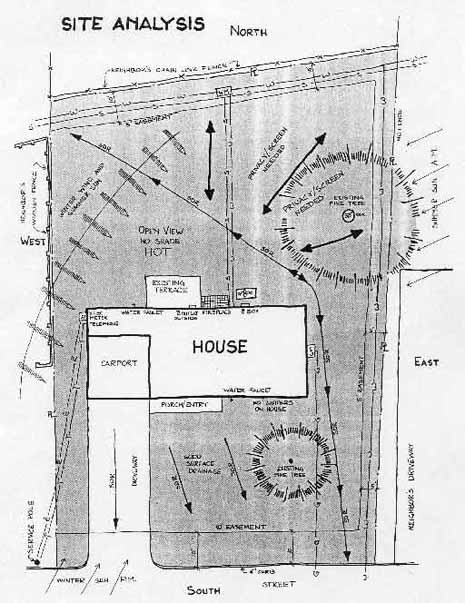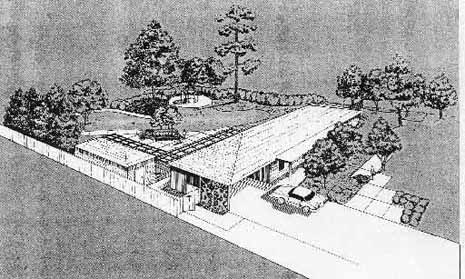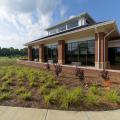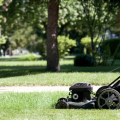Developing a Home Landscape Plan
A well designed landscape can provide years of enjoyment for your family and significantly add to your home's value. All good ideas begin with a plan. Homeowners that begin their landscape without a developed plan may end up less than satisfied with the results. Often, a home landscape is accomplished in individual, separate steps that do not coordinate as well together when completed. This is because an overall idea was not formed and resolved first, from which the individual components can then be completed. A plan is actually the result of a logical series of decision making.
A successful residential landscape plan must work functionally as well as aesthetically. Selecting plant types is actually the last step of the design process. Fully understanding the property's drainage, soils, and ecology; locating all existing site elements; developing a 'wish list' of use areas and locating them properly; and resolving these elements together into a successful format should be accomplished first. This publication is designed to assist you in the steps of the residential design process to help you develop a landscape plan. For planning or help with structural features, consult a qualified landscape architect for assistance.
The six steps of developing a landscape plan are summarized as follows:
- Develop a base plan.
- Conduct a site inventory and analysis.
- Assess your family's needs.
- Locate the use areas.
- Develop the use areas.
- Develop the planting plan.
Develop a base plan
A base plan, or plot plan, shows the layout of the property and accurately locates the permanent site elements on a residential lot. In urban areas and developments, lots have typically been surveyed. The property survey should show all property edges, setbacks and right of ways, building and pavement locations, and other permanent site elements. To construct your base plan, simply redraw the property survey to scale at a larger size. For small properties under an acre in size, a scale of 1"=10' is an appropriate drawing scale. Use an architectural ruler or an engineer's scale to measure, these supplies are available at most drafting or art shops. If there is no property survey, especially if you are interested in locating permanent structures adjacent property lines such as fences, pavement, etc., it is prudent to have a survey conducted by a reputable surveyor.
The base plan should show the following information:
- All property lines.
- Bodies of water (streams, lakes, ponds, low areas)
- Buildings, including
- floor plan with doors and windows
- downspouts
- outside water spigots
- outside electrical outlets
- decks and overhangs
- air conditioner units
- All walls, fences, utility boxes and poles, fire hydrants, etc.
- Roads, drives, parking areas, walks and paths, patios, swimming pools
- On and off site utilities including electric, telephone, gas, water, sewer, septic tanks, and field drains.
- Off site elements including adjoining roads and drives, bodies of water, and structures.
- Compass directions showing north, east, south, and west.
- The scale size of the base plan.

Conduct a site inventory and analysis
Take a clean sheet of tracing paper and tape it over the enlarged base plan. Label this sheet 'site inventory and analysis.' A site inventory is a list of all the additional site elements and environmental factors that were not listed on the base plan. A site analysis is an evaluation or judgement about the conditions of the site elements.
A site inventory should include:
- Locations of steep slopes, drainage swales, and where site water is draining.
- Soil types and characteristics.
- All existing tree, shrub and other vegetation types and locations.
- Locations of sunny and shady areas of the property.
- Summer and winter wind directions.
- Existing building and neighborhood architectural styles.
- Locations of storage and functional use areas.
A site analysis should include an evaluation of existing site features to preserve or improve:
- Health and condition of trees and shrubs.
- Where good views and poor views (both on and off site) of the property are.
- Items that need to be replaced or repaired, including fences, driveways, walls walkways, patios, etc.
- Health and condition of the lawn.
- Areas where erosion is occurring.
- Noting where drainage areas need to improve.
- Identifying valuable wildlife plants and areas.
- Identifying invasive exotic plants that should be removed.
- Evaluating front walkway appearance and quality.
- Identifying where shade areas need to occur.
- Need for improving storage or service areas.
- Noting any other features that need to be improved.

Assess your family's needs
With a base plan completed and a better understanding of the site, you are now ready to list your proposed use areas. Each family's needs and wants will vary with their outdoor activities. A few items to consider when developing your landscape plan needs may include:
- Use areas for family pets, such as open lawn.
- Identify outdoor needs for cooking areas, sun bathing, lounging, reading.
- What size and types of outdoor entertaining areas are needed?
- What types of recreation areas are needed for your family?
- How much maintenance are you willing to provide for gardens and use areas?
- Identify the budget that you willing to spend for various improvements.
- What are the outdoor storage needs for equipment, firewood, vehicles, or boats?
- What types of gardens, water features, or pathways do you wish to create?
- Do you wish to attract birds, butterflies, and other wildlife?
Locate the use areas
The outdoor areas of your property should have a strong relationship with the areas and activities within your home. For example, outdoor cooking areas should be located adjacent indoor kitchen or dining facilities. Service and storage areas should be located away from main use areas and views from the home. Patios and decks should directly tie into main circulation areas from the home.
Take another sheet of tracing paper and overlay onto the base plan. Draw zones where these different use areas could best occur to their approximate sizes. Try several different schemes until the best layout is evident.
Developing outdoor use areas
It is easier to develop each of the outdoor use areas separately and later combine them into the overall plan. Imagine yourself sitting within or using each area as you develop the design ideas. For example, to design a patio space, first decide on the elements that would make a successful seating area. Seats, tables, overhead shade structures, a sense of enclosure, views, water features, or other elements may be included. Reviewing garden magazines or books and visiting other successful spaces may provide visual ideas that may assist you. To get an idea of the size of a space, take a garden hose and roughly lay out the outline for the area. Move the garden hose to adjust the size of the space until it is the appropriate scale and form. It is best to select building material types and forms that will match and fit the character of the home and the surrounding area.
Developing a Planting Plan
A general list of plants that are suited to each of the unique conditions of the site should be generated first. Depending upon what your landscape offers, make a list of plants appropriate for sunny and dry conditions, sunny and wet conditions, shady and dry conditions, or shady and wet conditions. From this list of suitable plants, you may then choose combinations that best complement each other.
Planting areas should complement all outdoor use areas and architectural features. Planting plans typically start with the need and location of large shade trees, then smaller understory trees, then large shrubs, and finally smaller plants. Deciduous trees should be placed on the south and west side of the home to provide shade to the home and outdoor use areas in summer, yet provide sunlight during the cooler months. Draw in the outline of the plants at their maximum maturity size.
Planting beds should directly reflect the forms of all paving areas and outdoor use areas. If rectangular patio forms are selected, simply extend a rectangular planting bed of the appropriate size to complement. Remember to use the design principles of rhythm, unity, balance, and focal points for planting combinations.
For more information on planting design, see the Planting Design Fundamentals Landscape Fact Sheet.
Putting it all together
The form of the outdoor use areas should complement the architecture of the home and surrounding structures. For example, if the home has rectangular forms, then rectangular shaped patios, planting beds, fences, walls, and water features will best match. Clear and simple designs are always best, since combining various forms can be difficult to achieve successfully.
On another sheet of tracing paper, label it as 'preliminary plan.' On it, draw your ideal vision of each space to scale. Keep imagining and refining each space until it is fully resolved.
Establishing priorities
After you have completed your use areas and planting areas to your satisfaction, it is wise to make a list of priorities to accomplish the plan. Decide on the areas that need to be developed first, and tackle them one at a time as your budget and time allow. Here are a few suggestions to help you accomplish your goals:
- Finish all land leveling and grade changes first.
- Correct all drainage problems before beginning installations.
- All permanent hard surfaces such as patios, walkways, driveways and structures should be completed first.
- Since trees take time to mature, consider planting these early before other plantings.

These factsheets were written by Robert F. Brzuszek, Assistant Extension Professor, The Department of Landscape Architecture, Mississippi State University.
Publications
News
Landscape design and natural landscape enthusiasts will gather at Mississippi State University to perfect their craft and learn from other experts, an annual event happening this year on Oct. 18. The 68th Edward C. Martin Landscape Symposium will be held from 8:30 a.m. to noon at the Bost Auditorium at MSU.
May is here and you know what that means, it’s go time!



